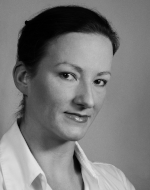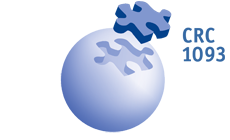CRC 1093 - Scientific Coworker Christine Beuck
Dr. Christine Beuck

Phone: +49 201 183 2929
Email
Structural and Medicinal Biochemistry
Centre for Medical Biotechnology (ZMB)
Faculty of Biology
University of Duisburg-Essen
Research
Nuclear Magnetic Resonance (NMR) spectroscopy
NMR spectroscopy is a versatile tool to study proteins and their molecular interactions. As part of the CRC 1093, I investigate both the interactions of proteins with their natural binding partners and synthetic ligands designed to target protein surfaces.
NMR is a powerful method that can directly determine the protein residues involved in interactions with other biomolecules or synthetic ligands. I established the use of side chain specific NMR experiments for lysine and arginine residues to precisely monitor supramolecular ligand binding, which, in contrast to the standard amide 15N-HSQC experiment, allows to rank multiple binding sites within one protein. For larger proteins, fast-acquisition (BEST-TROSY; SOFAST) as well as Methyl-TROSY experiments are employed. Furthermore, NMR is used to determine the structures of proteins or isolated domains and probe their size, oligomerization status and dynamics or reaction kinetics.
Protein Structure Determination
I elucidate the structures of proteins with both solution NMR spectroscopy and X-Ray crystallography.
NMR structures:
- 2MXT: Acidic Domain of the human splicing factor SYNCRIP (24-107), BMRB # 25970.
- Acidic Domain of the human splicing factor SYNCRIP (24-140) (pdb 2NBB, NMR structure), BMRB # 25428.
X-Ray structures:
- 4DNN: Qua1 Homdimerization domain of the human splicing factor Quaking
- 3K6T: Qua1 homdimerization domain of the C. elegans translational regulator GLD1.
- 3KBL: Qua1 domain N169A mutant of the C. elegans translational regulator GLD1
Biochemical Characterization of Protein Complexes
To perform their task within the cell, proteins are interacting with a multitude of other biomolecules like other proteins, nucleic acids, polysaccharides or small molecule cofactors. If these interactions are not functioning properly within a cell, a multitude of diseases can occur. The supramolecular ligands developed within the CRC 1093 aim to target and modulate such biological interactions. We use a multitude of biochemical techniques, e.g. fluorescence, UV and CD spectroscopy, Isothermal Titration Calorimetry, Biolayer interference (BLI), cross-linking, to study both the interactions of biomolecules with their native and synthetic binders.
Curriculum Vitae
Professional career
| 2014-today | Assistant Professor (Habilitandin) with Prof. Dr. P. Bayer, University of Duisburg-Essen, Germany. |
| 2014 | Staff Scientist with Prof. Dr. J. R. Williamson, The Scripps Research Institute, La Jolla, USA. |
| 2012-2014 | Senior Research Associate with Prof. Dr. J. R. Williamson, The Scripps Research Institute, La Jolla, USA. |
| 2005-2012 | Research Associate (Postdoc) with Prof. Dr. J. R. Williamson, The Scripps Research Institute, La Jolla, USA. |
| 2005 | Guest scientist with Prof. Dr. M. Shionoya, Tokyo University, Tokyo, Japan, as part of the GDCh/DFG Japan exchange program 2005. |
| 2003 | Exchange researcher with Dr. habil. S. Klimašauskas, Institute of Biotechnology, Vilnius, Lithuania. |
Scientific education and degrees
| 2001 - 2005 | Ph.D. in Chemistry, with Prof. Dr. E. Weinhold, RWTH Aachen |
| 1996 - 2001 | Study of Chemistry (Dipl.) at the Technical University of Dortmund, Diploma thesis with Prof. Dr. E. Weinhold, Max Planck Institute for Molecular Physiology |
Publications
S. B. van der Meer, K. Loza, K. Wey, M. Heggen, C. Beuck, P. Bayer, M. Epple, “Click chemistry on the surface of ultrasmall gold nanoparticles (2 nm) for covalent ligand attachment followed by NMR spectroscopy”, Langmuir 2019, 35, 6288-6296.
Supplemental Cover.
T. Ruks, C. Beuck, T. Schaller, F. Niemeyer, M. Zähres, K. Loza, M. Heggen, U. Hagemann, C. Mayer, P. Bayer, M. Epple, “Solution NMR Spectroscopy with Isotope-Labeled Cysteine (13C and 15N) Reveals the Surface Structure of L‑Cysteine-Coated Ultrasmall Gold Nanoparticles (1.8 nm)”, Langmuir 2019, 35, 767-778.
Supplemental Cover.
A. Hogeweg, A. Sowislok, T. Schrader, C. Beuck, “An NMR Method to Pinpoint Supramolecular Binding to Basic Residues on Proteins”, Angew. Chem. Int. Ed. 2017, 56, 14758 –14762; Angew. Chem. 2017, 129, 14953 –14957.
C. Beuck, J. R. Williamson, K. Wüthrich, P. Serrano, “ The acidic domain is a unique structural feature of the splicing factor SYNCRIP”, Protein Sci. 2016, 25, 1545-1550.
F. Trusch, K. Kowski, K. Bravo-Rodriguez, C. Beuck, A. Sowislok, B. Wettig, A. Matena, E. Sanchez-Garcia, H. Meyer, T. Schrader, P. Bayer, “ Molecular tweezers target a protein–protein interface and thereby modulate complex formation“, Chem. Commun. 2016, 52, 14141-14144.
J. van den Boom, F. Trusch, L. Hoppstock, C. Beuck, P. Bayer, “Structural Characterization of the Loop at the Alpha-Subunit C-Terminus of the Mixed Lineage Leukemia Protein Activating Protease Taspase 1”, PLoS One 2016, 11, e0151431.
C. Beuck, E. Weinhold, “Reversibly locked thio nucleobase pairs in DNA to study base flipping enzymes“, Beilstein J. Org. Chem. 2014, 10, 2293–2306.
C. Beuck, S. Qu, W. S. Fagg, M. Ares Jr., J. R. Williamson, "Structural Analysis of the Quaking Homodimerization Interface", J. Mol. Biol. 2012, 423, 766–781.
C. Beuck, B. R. Szymczyna, D. E. Kerkow, A. B. Carmel, L. Columbus, R. L. Stanfield, and J. R. Williamson, "Structure of the GLD-1 homodimerization domain: Insights into STAR protein-mediated translational regulation", Structure 2010, 18, 377–389.
Discussed in: C. D. Cukier, A. Ramos, "Creating a Twin STAR", Structure 2010, 18, 279-280.
R. Repges, C. Beuck, E. Weinhold, G. Raabe, J. Fleischhauer, "6-Thioguanine in DNA as CD-Spectroscopic Probe to Study Local Structural Changes upon Protein Binding", Chirality 2008, 20, 978–984.
I. Singh, C. Beuck, A. Bhattacharya, W. Hecker, V. S. Parmar, E. Weinhold, O. Seitz, “Abasic site stabilization by aromatic DNA base surrogates: High-affinity binding to a base-flipping DNA-methyltransferase”, Pure Appl. Chem. 2004, 76, 1563–1570.
C. Beuck, I. Singh, A. Bhattacharya, W. Hecker, V. S. Parmar, O. Seitz, E. Weinhold, “Polycyclic Aromatic DNA-Base Surrogates: High-Affinity Binding to an Adenine-Specific Base-Flipping DNA Methyltransferase”, Angew. Chem. 2003, 115, 4088-4091, Angew. Chem. Int. Ed. 2003, 42, 3958-3960.
C. Beuck, E. Weinhold, “Convenient Synthesis of Oligodeoxynucleotides Containing 2’-Deoxy-6-thioinosine”, Nucleosides, Nucleotides & Nucleic Acids 2003, 22, 635-639.
A. David, N. Bleimling, C. Beuck, J.-M. Lehn, E. Weinhold, M.-P. Teulade-Fichou, “DNA Mismatch-Specific Base Flipping by a Bisacridine Macrocycle”, ChemBioChem 2003, 4, 326-1331.


